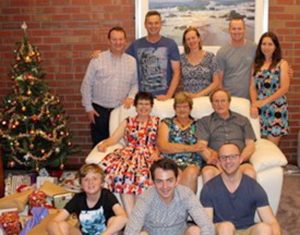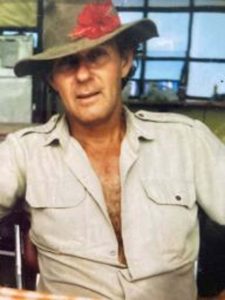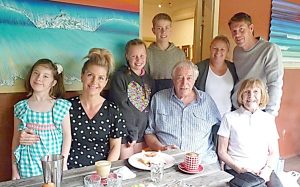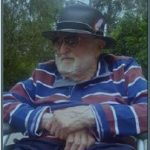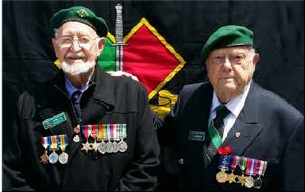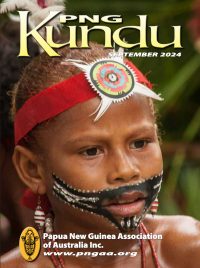VALES & TRIBUTES
CLIFFORD | DAVIES | MAYNARD | McCARTHY | MOORE | NEEDHAM | PELIKAN | TAYLOR | WILLIAMS
CLIFFORD, Leon
Saturday, 18 May 2024
The PNG Forestry mob has lost another Forest icon with the passing of Leon Clifford. Many knew Leon and his work in PNG between 1958 and 1975, especially in forest research and when Leon was Principal of the Bulolo Forestry College and then Regional Manager Lae.
In 1963 Leon Clifford was transferred from Kerevat to Bulolo where he worked on tree improvement in Araucaria spp. During that time, Leon surveyed termite damage in the hoop pine plantations. In 1965 Leon was appointed Acting Principal of the Bulolo Forestry College following the departure of Joe Havel.
The yield plots, which Leon established during his days of Forest Research, were used by the students at the forestry college for training in mensuration and growth studies.
Leon left Bulolo in 1969 to accept a position as Regional Forestry Officer in Lae. Leon’s area covered the coastal regions including Lae, Vanimo, Wewak, Madang and the Sepik River.
In 1976 Leon departed PNG and moved back to Newcastle NSW, living near family. He went into business and began voluntary work for the Saints Church. In 1980 Leon was approached to work full time for the church with his first appointment being District President for the Newcastle area. In 1986 he was appointed to Brisbane and the South Pacific area and then in 1990 Melbourne, where he settled.
Highlights of Leon’s 20 years working for the church include his ministry in the South Pacific area, returning on two occasions to Lae and Buso, encouraging children, youth and family ministries. Leon also assisted in the establishment of church campgrounds at Kallara in Victoria, growing, planting and nurturing many hundreds of trees.
Upon his retirement in 2001, Leon spent time with his family and travelling in Australia and overseas. Leon is survived by his wife Janelle, son Noel and daughter Kerin.
Dick McCarthy
DAVIES, Professor Hugh Lucius AO, OL
Friday, 26 April 2024
Hugh Davies passed away after a short illness in Canberra at the age of 89. He is survived by his wife of 60 years, Connie Lou, and an extended family. Hugh met Connie Lou while studying for a PhD at Stanford University in California in 1964. He remarked that the $10 cost of the marriage licence was the best money he ever spent.
Following a private family committal and a chance for the family to grieve a much-loved man, a public celebration and thanksgiving for Hugh will be held at a later date. In lieu of flowers, the family requests a donation in his name be made to Guide Dogs Australia: https://nsw.guidedogs.com.au.
Several tributes can be found on the Internet, nearly all attributing Professor Hugh Davies AO, OL as the ‘father of PNG geology’. This was a worthy title given that he first arrived in PNG in 1956 as a 23-year-old geologist with the Bureau of Mineral Resources, working on geological mapping and studying plate tectonics and volcanology. Hugh often mentioned one of the highlights of his first trip to PNG was meeting a young Michael Somare, with whom he remained friends until Sir Michael’s death in 2021.
Hugh held many leadership roles in government, industry and the community, including Chief Government Geologist of the newly formed PNG Geological Survey from 1973 to 1981. Following the 1998 Aitape tsunami, Hugh Davies turned his attention to addressing the disaster arising from plate tectonic movements. It was a natural progression that led him to develop the National Disaster Awareness and Preparedness Committee from 1999 to 2007, of which he was Chairman.
In 2001, Hugh founded and became the inaugural director of the Centre for Disaster Reduction at the University of PNG (UPNG), having taught and mentored more than 500 geology graduates. He created and led the UPNG’s Earth Science Department, making it competitive in the world and earning him the title of Father of Geology in PNG. On 30 April, the Post Courier wrote:
Many of his former students have gone on to greater things in life, tinkering with rocks, studying volcanoes, diving into fault lines, and being ‘shaken’ by tremors, earthquakes and powerful ‘gurias’.
In 2005, Hugh received the Order of the Logohu (OL) from the PNG Government for services to geological education and disaster relief.
In 2006, the American Association of Petroleum Geologists awarded him the Michael T. Halbouty Human Needs Award for the same purpose. From 2007 to 2009, Hugh was Executive Manager of the newly formed Geological Survey Division at the Mineral Resources Authority. He was the first Managing Director of Ok Tedi Development Company and the first Executive Manager of the Geological Survey Division of Mineral Resources Authority. Hugh authored several books, including Earth Tok (2014). His research output was prolific, with over 100 academic papers on PNG’s geology.
Retiring from UPNG in 2018, Hugh and his family left PNG but continued maintaining close contact with the staff and students of Earth Science until his passing. He continued working on his latest research on PNG geology, helping former students with research and study opportunities and connecting with colleagues from PNG and other countries. This continued up until two days before his death.
In 2018, Hugh was made an Officer of the Order of Australia (AO) for distinguished services to Australia-Papua New Guinea relations in the area of geological sciences and to education as an academic, author and researcher.
This tribute was compiled from information gleaned from the following sites:
https://devpolicy.org/father-of-geology-in-png-dies-at-89-20240502/
MAYNARD, Peter
Tuesday, 16 April 2024
Peter Maynard passed away at Regis Aged Care in Birkdale in the arms of his daughter, Simone Maynard.
Peter, the son of Stanley Charles Hilton Maynard (Mick) and Bertha May Maynard (Bid), was born in Western Australia on 25 December 1943. He was the brother of John Maynard, and was previously married to Andrea and later to Rose. Peter leaves behind three daughters -Margaret, Narelle and Simone, and three sons – Michael, Warren and Price, as well as ten grandchildren and his beloved dog, Bear.
Peter travelled to Papua New Guinea where he performed his role as kiap during the 1960s and ’70s. Peter was Assistant District Commissioner in Bereina and Kikori, before ending up in Port Moresby at the District Office Post-PNG Independence.
Peter returned to Australia to serve in the RAAF’s 77 Squadron. After leaving the RAAF, Peter worked in real estate and opened Lemon Tree Passage Real Estate in NSW. Later he returned to PNG in community liaison roles for mining and forestry companies and he also worked in local governments in northern Queensland.
Peter was an avid sailor and a celebrated member of various yacht clubs and, in his spare time, he built ketches. There was nothing Peter liked more than a yarn with mates and Peter’s friendships were many and strong. He was known for his loyalty, his witty sense of humour and great smile. A man who would take the shirt off his own back to give to others, he will be greatly missed by family, friends and communities from the west to east coast of Australia and in PNG.
We organised a charter yacht to farewell Peter with a three-hour sunset cruise on 19 May 2024 so that his ashes could be scattered at sea off the Brisbane coast. Attendees drank Spumante, the name of the first yacht that Peter built.
Simone Maynard
McCARTHY (née Missen), Margaret Rose
Wednesday, 5 June 2024
Our best friend, wife, mother, grandmother and companion of 52 years, my wife—Margaret Rose McCarthy née Missen, passed away surrounded by her family at the Blue Cross Aged Care Facility Westgarth, in Victoria, after a lengthy battle with dementia.
Margaret was the eldest daughter of Mary and Alan Missen, formerly of Queens Street, Dookie in northern Victoria. Her siblings are Maureen (Tod) Seedsman, Faye Boland (deceased) and Ronald Missen.
Throughout her life Margaret continually displayed her love of art, fashion, animals, travel, her Catholic faith, music and culture. She loved her home place of Dookie, where she attended Dookie Primary School and then Sacred Heart College in Shepparton. After completing her schooling, Margaret travelled to Melbourne to take up work with the Commonwealth Bank of Australia and the Reserve Bank of Australia, during which time she resided at St Ann’s Hostel in Central Melbourne.
A major highlight of Marg-aret’s life in 1965 was when she left Australia on the Northern Star for a two-year stint to live and work (Australia House, London), including travelling throughout Europe. Returning from Europe, Margaret moved to Port Moresby in 1969 to work for the PNG Crown Law Department.
Margaret met Richard McCarthy in 1971 at a Red Cross function that was held at the Papuan Hotel (otherwise known as Top Pub). They were engaged in May 1972 and married at St Joseph’s Catholic Church in Boroko, Port Moresby, on 7 October the same year. Margaret’s mother Mary, her sister Tod and Uncle Paddy Quinane travelled to Port Moresby for the wedding.
In 1973, Margaret and Richard moved to Bulolo in Morobe Province where Richard was a senior lecturer at the Bulolo Forestry College before being appointed District Forester for the Bulolo Wau Forestry District. Margaret returned to Australia for the birth of daughter Llewellyn Maree, born in Shepparton Victoria, after which mother and daughter returned to Bulolo.
It was the year of PNG’s Independence, in 1975, when Margaret and Richard returned to Australia so that Richard could undertake studies for his Masters in Forest Management at the Australian National University (ANU) in Canberra. While the family lived in Canberra, Margaret and Richard’s son, Roderick Patrick, was born.
The family moved to Traralgon in Gippsland, Victoria, in 1977, where Richard was the Operations Manager for APM Forests (part of AMCOR). Llewellyn and Rod received their primary and secondary school education at the Traralgon Catholic Education schools. Margaret’s work as a Gippsland artist grew during this period. One of her achievements included a large mural on the approaches to Traralgon adjacent to the local golf club.
During this time, many overseas trips were undertaken, one of which included all the family in 1982 to the USA (including Disneyland), whilst Richard was undertaking a study program for AMCOR. Global travel again beckoned in 1995 when the McCarthys moved to Sumatra in Indonesia, where Richard was the regional manager for a large pulp and paper company. That same company supplies paper products to Coles and Officeworks today.
In 1996, AusAID came knocking, resulting in the family moving again to PNG, this time to Lae, where Richard was a forestry adviser to AusAID, a role he held until 2000. During this period, Margaret and Richard purchased their home in Jessie Street, Westgarth (Northcote). Margaret took up residence at Jessie Street whilst Richard commuted between Westgarth and PNG.
Margaret continued her painting with the East Melbourne Artists Co-operative. That lifestyle continued until 2015 when Richard partially retired from overseas management consulting to look after Margaret in Westgarth.
Margaret is survived by her husband Richard, a daughter Llewellyn Maree, granddaughter Saskia and her partner Rodger, a son Roderick Patrick, his wife Tori and grandchildren Thomas and Hannah.
Richard (Dick) McCarthy
MOORE, Capt. William
Tuesday, 18 June 2024
It is with extreme sadness to report that Capt. William (Bill) Moore, a long-time distinguished aviator of the Territory of Papua & New Guinea (TPNG) and later PNG, made his final landing at home in Brisbane. His long-time wife, Serena, was with Bill until he was ‘on chocks’.
Having amassed some 20,000 plus flying hours in an unblemished career, Bill’s aviation career in PNG began in the early 1970s when he flew for Aerial Tours out of Port Moresby. He went on to become a formation pilot with MacAir, which was formed by Bryan McCook and Dave MacLure, before launching with Graham Syphers, a competitor to Territory Airlines.
In 1973, Bill was recruited by TAA for its TPNG division as DC-3 captain. Around that time, Bill was a flight instructor at the South Pacific Aero Club at Port Moresby’s Jackson’s Airport.
As a DC-3 captain, Bill moved to Air Niugini when it was launched in late 1973. One of Bill’s most memorable DC-3 flights was when he was assigned to ferry one of these iconic aircraft from Lae to Tullamarine Airport, Melbourne. That particular aircraft was historically significant in that it was the first TAA DC-3 to go online, so it was planned to be a company flag waver for promotional events.
Bill was paired with a senior TAA management captain. All went well until the landing at Melbourne. The TAA ‘heavy’ decided that tradition dictated he should carry out the landing. He announced that he would be carrying out a tail-down ‘wheeler’ only he hadn’t taken into account that it was night-time and there was a gusty south-westerly wind accompanied by rain showers.
The landing looked to becoming totally out of control as the aircraft started into a well-defined ground loop! Quickly taking over, Bill managed to bring the aircraft under control from the right seat, avoiding major embarrassment to TAA, and not least to TAA’s designated senior ‘heavy.’
Not long after, Bill was promoted to Air Niugini’s B707-320, and I crewed with him on many occasions. One trip that came to mind was the Air Niugini—United Nations contract transporting a Fiji battalion from Nadi to Beirut, Lebanon, and later to Tel Aviv, Israel. This type of operation required crews to think outside the box. Bill ran a master class when it came to such operations.
Eventually, our B707 fleet was replaced by an ex-TAA A300-B4 and, once again, Bill displayed his experience to the full as he continued with the airline’s Asian and Australian operations.
Bill moved to Singapore Airlines, flying the ‘plastique fantastique’ A340-200 on the European routes before retiring to Brisbane, initially at Newport Waters and later at Mango Hill.
I have attended several Air Niugini crew reunions in South East Queensland organised by Bill—they were always a merry affair with lots of stories, not all entirely truthful I might add.
A PNG Legend has left us, and we are the poorer for it. Rest in Peace, Bill. We will miss you.
Capt. Garry Honour Rtd.
NEEDHAM, Terence
Thursday, 2 May 2024
Terence (Terry) was born in Bowral, NSW on 27 April 1939 and his parents lived at Hilltop. In 1943, he and his mother moved to Westmead, Parramatta to live with his grandmother, while his father was enlisted during World War II. His father was demobilised in 1946 and they travelled to Papua New Guinea where he was employed as a plantation assistant at Mai Mai Plantation near Samarai.
At the age of seven, Terry joined his parents in Mai Mai via steamship in July 1946 and commenced correspondence schooling. They then moved to Raua Estate in Bougainville in 1949. Terry travelled from PNG to All Souls St Gabriel’s Boarding School in Charters Towers, Queensland in 1950.
In 1953, the family moved to Belik Plantation on New Ireland when Terry was boarding at The King’s School, Sydney. He returned home once a year while at school due to the remote location and travel difficulties. While at King’s, Terry went to junior Macquarie House in 1951 as a day student, then boarded from 1952 until 1956 at senior Macquarie House. Terry loved his time at The King’s School and remained in contact with many friends throughout his life.
In 1956, Terry left school and planted three coconut and cocoa properties, Kenapit, Tersue, named after him and his sister Susan, and Rubio. He worked on Belik and married Liane Neilsen in 1964. Their wedding was held at The King’s School Chapel.
Having been a Master Mason in Kavieng Lodge No. 487, Terry was Master twice for the Lodge, as well as secretary for the New Ireland Planters’ Association, which sent a delegation to Malaysia to exchange ideas on cocoa, copra and rubber.
Two of Terry and Liane’s children were born in Rabaul at Nonga Base Hospital and two in Brisbane. Whilst living in New Ireland, Terry managed and leased four properties and Bululogan Plantation until 1985 when the family relocated to Brisbane.
Whilst living in Brisbane, Terry owned several businesses including a kindergarten/childcare centre, lettuce, avocado and custard apple farms, and three food outlets.
Terry had eight grandchildren and was involved in numerous sports including tennis and golf. During his retirement, he enjoyed spending time with family, travelling and caravanning around Australia. Following a brave 14-month battle with pancreatic cancer, Terry passed away on Thursday, 2 May 2024, five days after celebrating his 85th birthday, with family at his bedside.
Jodi Ord
PELIKAN, Milos Jan
Saturday, 15 June 2024
Milos was born in Prague, Czechoslovakia on 27 June 1926, to parents General Dr Rudolf Pelikan and Jana Pelikanova. His father was one of 16 Generals who were hand-picked by TG Masaryk (the first President) to establish the independent nation of Czechoslovakia, following the renowned Czech Legion campaign of WWI. His mother was a successful businesswoman in the Vilemov region.
Milos studied at an agricultural college in Czechoslovakia in the late 1940s but did not complete the degree due to the political upheaval after WWII, which saw the Communist Party seize power after a coup in 1948.
Thousands of students fled the country ending up as refugees. Milos was one of these students, together with friends, who ended up as a United Nations Displaced Person/Refugee, arriving in Melbourne, Australia in 1950 aboard the Fairsea.
This cohort of European refugees after World War II were nation builders: refugees in Australia at that time were required to work as manual labourers regardless of their education or skill level.
Milos worked on the wharves in Port Melbourne for a number of years and then, in 1962, applied for a position as Assistant Inspector (Lands) in Papua New Guinea (PNG) for the Department of Territories, Canberra.
He wrote in his application that he had worked in Melbourne as a labourer for State Rivers and Water Supply Commission, Johns & Waygood Ltd and Australian Stevedoring Authority.
He was awarded the role and moved his young family to the mandated Territory of Papua and New Guinea under the Australian administration.
Milos was stationed at the Australian Administrative Headquarters in Port Moresby, working for the Lands, Surveys and Mines Department. He was successful in his work there and continued his service until PNG gained self-government status and entered the transition to Independence, which it gained on 16 September 1975.
On 3 August 1973, Milos received a personal request from Michael Somare (the Founding Father of PNG) to continue his work in PNG until after Independence. In the letter he acknowledged Milos’ contribution to PNG and its people and wished that he stay on. Michael Somare stated:
. . . (I wish) that you should continue your service in Papua New Guinea
This decision to invite you to continue your service to this country at a time when localisation is so important to us has not been taken lightly. It results from careful inquiry by your department head in consultation with Ministers and the Public Service Board. Your personal past contribution to the development of this country has been particularly taken into account.
I appreciate that there are a number of considerations important to you personally that must influence your decision whether or not to accept my Government’s invitation for you to continue the services that we so highly value.
I look forward to your continued association with, and contribution to, the development of this nation.
The letter is signed by Michael Somare, Chief Minister.
Milos agreed to continue working in PNG. His position at the date of termination of employment in PNG (1976) was Head of Land Settlement Division, Lands, Surveys and Mines Department.
Milos is acknowledged in the first government performance review, ‘Programmes and Performance 1975–76’, prepared by the National Planning Committee (continued work of the 1974–75 document, ‘Strategies for Nationhood: Programmes and Performance’).
He made a significant contribution not only to the Australian Government administration prior to Independence but to the fledgling PNG Government as it established nationhood.
Milos retired to Melbourne, Australia, with his wife Mary Pelikan. After the opening of travel to Czechoslovakia in 1989, Milos returned to his beloved homeland, reuniting with his sisters and family spending considerable time there over many years.
In 1991, 41 years later, he was awarded his Agriculture Degree in Prague along with other students.
Before he passed away, Milos met with a Czech historian who had been compiling the stories of Czechs in Australia over the decades. Milos’ life and achievements will be featured in the upcoming book.
In Loving Memory Always, Yana and Family
TAYLOR, Rev. Harold W
Monday, 22 April 2024
Harold William Taylor was born on 6 November 1932 at Pascoe Vale South, Victoria. His family was very involved in the Methodist Church and Harold soon began his own journey of faith.
He attended Coburg High School, left at the end of Year 10 but continued his studies at night school, gaining matriculation and then his BA and BD.
Harold’s favourite recreation was Aussie Rules, through which he met his future wife, Barbara Johnson, whom he married in 1958. By this time, he was training as a minister of the Methodist Church and was ordained in 1960.
Their daughter Jenny was born in 1959 and their son Andrew in 1961.
In 1961 the Taylors went to the Territory of Papua and New Guinea as missionaries and were first stationed at East Cape, the easternmost tip of the main island of New Guinea. Two more children, Cathy and Paul, were born in the family’s early years in the Territory.
In 1965, Harold became a lecturer at Rarongo Theological College, near Rabaul. He was a senior member of the college staff and was highly esteemed for his knowledge and understanding of PNG culture. He wrote several books, including Tend My Sheep on pastoral care. Barbara’s nursing skills were appreciated by staff and students, and both were caring mentors for the students. In 1976 the Taylors returned to Australia. Harold joined the staff of the Bible College of Victoria (BCV), where he remained for 20 years, becoming Vice-Principal.
In addition to his work in the BCV, Harold had a leading role in the Community of Hope, and also joined the Order of Saint Luke, an international healing ministry, and was Warden of the Order in Australia. As part of this ministry, he wrote the large book, Sent to Heal: A Handbook on Christian Healing.
The Australian College of Theology awarded him the honorary degree of Doctor of Theology for his exceptional work in all these fields.
Even when ‘retired’ Harold kept up pastoral work in many ways, ministering to people in whatever group he was with.
The last few months of his life were spent in Walmsley Retirement Community in Kilsyth, Victoria, where he passed away on 22 April 2024, aged 91. Harold is sadly missed by Barbara; his children Jenny, Andrew, Cathy and Paul; their partners Sally, Lynn and Sharon; his grandchildren and great-grandchildren; and his many friends.
Neville Threlfall CSM
WILLIAMS, Cynthia Schmidt
Sunday, 28 July 2024
More information in the next issue.
Farewell to the Last Coastwatchers
I attended the funeral services on 14 and 15 July 2024 for the last two Coastwatchers of World War II – Ron ‘Dixie’ Lee at Werribee and Jim Burrowes at Box Hill. I regret never meeting ‘Dixie’; they died within 12 hours of each other, aged 100 and 101 years respectively.
I first met Jim in Rabaul in 2014 for the centenary of the capture of the German wireless station at Bitapaka, East New Britain, by the Australian Naval & Military Expeditionary Force. Jim was generous with his time, later accompanying me to the Signals Museum at Watsonia Barracks. On display was an ATR4 dry-cell radio transmitter (about the size of a letterbox) of the type Jim used behind the lines in the Baining Mountains in 1944 – 45, observing Japanese positions around Rabaul.
Incidentally, also on display were replicas of the radio set ‘Winnie the War Winner’, as cobbled together by 2/2nd Independent Company signallers in East Timor in 1942, and an AWA radio transmitter (three components each the size of an overnight bag, plus the essential generator set with fuel and oil), as distributed to Coastwatchers before Pearl Harbor. Each AWA set required a team of 16 carriers on standby, night and day, ready to escape with the set if attacked. Coastwatchers were resupplied with cash to feed and shelter their carriers by RAAF Catalinas; occasionally, evacuees or rescued airmen were taken off by USN submarines.
I’ve included the link to an obituary written by Vice Admiral Peter Jones AO, DSC (Retd), for both Coastwatchers, that appeared in The Sydney Morning Herald and The Age on 10 July. I believe he will be delighted if their obituary can be accessed through the PNG Kundu: https://www.smh.com.au/national/australia-s-last-two-ww2-coast-watchers-die-aged-100-and-101-20240710-p5jsdw.html
On behalf of the RAN, Vice Admiral Jones honoured both men by presenting a folded, encased White Ensign to Mem and Beryl and their families. A uniformed RAN bugler sounded the ‘Last Post’ and ‘Reveille’ for Dixie, and a RAN honour guard presented arms when Jim’s casket was carried to the hearse.
Additionally, Colonel Doug Knight, President of the Australian Commando and NGVR Associations, together with RSL representatives, paid tribute to each Coastwatcher and their families.
Reg Yates


